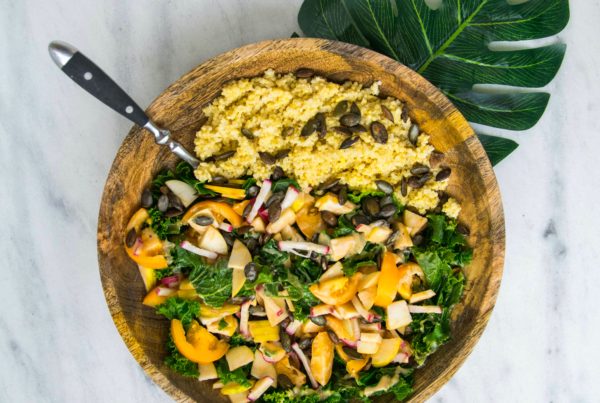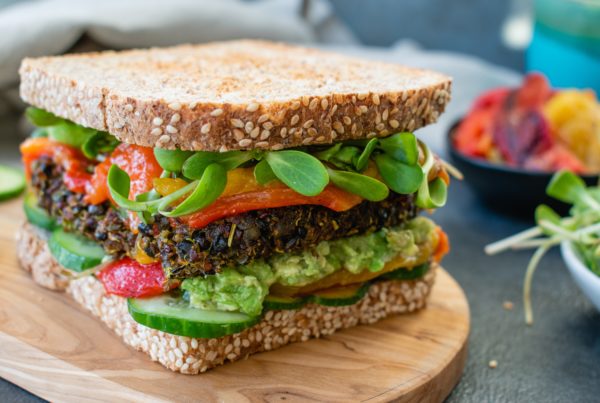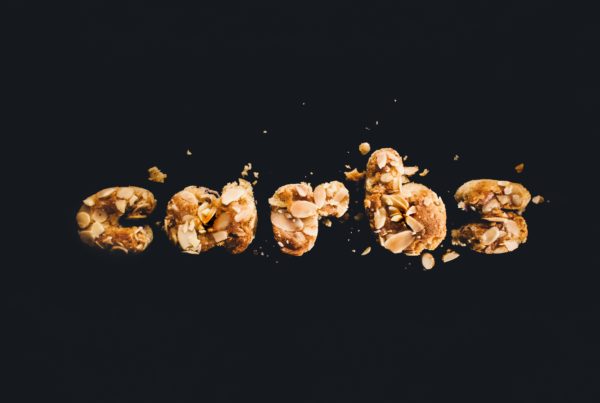“And the last step – let’s add some chia seeds to our just-prepared smoothie! Why? Because – Fiber!” You probably have heard that countless times whether watching your favorite YouTube channel or reading a nutrition blog about the benefits of eating plant-based foods. But do you know why fiber is so important for your health? Or, if all fiber is the same? Today, we will shed light on two different types of fiber and elucidate in a detailed yet very simple way how these amazing polysaccharides can lower blood cholesterol, slow the absorption of glucose in your body, and improve the function of your gut!
The Definition, Types, and Sources
There are two types of carbohydrates: simple and complex. The first group is represented by mono- and disaccharides such as sucrose, fructose, glucose, or lactose, which can be found in table sugar, honey, fruits, or dairy products. On the contrary, polysaccharides such as cellulose, pectin, gums, or amylopectin constitute the second group. Examples of foods that are rich in this type of carbohydrates are wheat, rice, legumes, tubers, vegetables, seeds, nuts, and fruits. While amylopectin belongs to starches, cellulose, gums, and pectin constitute dietary fibers and can be found in all plant food sources. Most of the dietary fibers are carbohydrates, however, as always, there are some exceptions. For example, one of the most common fibers, lignin, belongs to another class of organic molecules.
The main characteristic of fibers is that they cannot be digested by human enzymes yet some of them can be digested by gut bacteria. We just don’t have a specific enzyme that would be able to break down these big molecules into smaller monosaccharide units. Such an ability to go through your digestive tract untouched helps to regulate many processes in your body such as blood glucose levels or the state of being sated.
Two Types of Dietary Fiber – Lots of Food Sources
Two important types of fiber are classified by their ability to dissolve in water: soluble and insoluble. Pectins and gums are great examples of soluble fiber. However, fibers such as cellulose or lignin are insoluble in water. Both types can be found together in the same food; only their ratio varies. Apples, for example, would contain insoluble fiber in the peel and soluble fiber in the flesh.
Besides apples, the most proportion of soluble fiber compared to the insoluble one can be found in oats, legumes, nuts, barley, and citrus fruits. This group of fibers is responsible for maintaining blood glucose and cholesterol levels, which will be discussed in more detail further.
Foods such as wheat bran, whole grain cereals, and vegetables, on the other hand, have a higher content of insoluble fiber. This fiber allows these foods to attract water into your gut and soften the stool making its elimination quicker and easier.
Most Important Benefits of Soluble Fiber
Soluble fiber is well-known as a heart disease and diabetes protector.
It helps decrease blood cholesterol. Your liver constantly produces around 1 L of bile per day – a special liquid that is required for fat digestion. The important thing about bile is that it consists of cholesterol and after being used in vital digestive processes it always gets reabsorbed by the liver. Soluble fiber can bind bile in your digestive tract and make it eliminated with the feces preventing its reuse. This means that now your liver needs to create new bile juice by using cholesterol available in your blood. Soluble fiber can also be fermented by bacteria in your gut producing compounds that may prevent cholesterol synthesis in your liver. Eventually, these processes lead to a decrease in total cholesterol levels in your blood.
It slows glucose absorption. Here, the situation is less complicated than with bile and cholesterol. Every time you eat cooked beans or apples, soluble fiber found in them helps to delay the release of chyme (it is the mass of mechanically digested food that goes from the stomach to your gut!) Now, the transition time of food you just ate through the digestive tract is lowered. It can also lead to a lower amount of glucose going from the food into your blood. Such characteristics of soluble fiber protect you from an immediate spike in glucose levels in the blood, which were linked to an increased risk of diabetes.
Key Health Effects of Insoluble Fiber
First and foremost, insoluble fiber can boost your gut health by making the walls of your large intestine stronger and healthier – great prevention of diverticulitis! By attracting water to your gut, insoluble fiber can make your stool softer and larger, which helps to make its transit easier for your rectal muscles and decreases the pressure in your colon. This, in turn, prevents hemorrhoids as now the chance that your rectal veins get swollen is significantly lower. Eating an adequate amount of insoluble fiber and drinking plenty of water will also avert constipation and impaction.
Are There Only Benefits to Eating Fiber?
As always, everything is good in moderation! Overconsumption of dietary fiber with a low intake of water can lead to serious problems such as constipation or essential micronutrient deficiency (yes, fiber can bind minerals, too!). Currently, the daily recommendation for total dietary fiber intake for women is 25 grams and for men is 38 grams. We know that starting your journey in a high-fiber lifestyle and reaching this amount is not that easy. That’s why we prepared a list of 5 tips that would help you to incorporate fiber into your diet smoothly and comfortably.
5 Tips for Incorporating Fiber into Your Diet
- Add it gradually as your gut bacteria require the time to adapt to the new foods. A drastic shift to a high-fiber diet may lead to bloating.
- Drink enough liquids, so you will be able to enjoy all the benefits dietary fiber has to offer. Insufficient intake of water can result in dehydration of feces and its unsafe blockage in your gut.
- Switch at least 50 percent of processed carbs that you eat a day to whole ones. Substituting white rice for the brown, wheat spaghetti for the whole grain, or all-purpose flour for the whole wheat would be a great first step.
- Don’t miss breakfast as it is an amazing opportunity to include oats, seeds, and a variety of fruits in your diet. It could be one portion of overnight oats sprinkled with chia seeds or fluffy and delicious pancakes made from oat flour!
- Why not try new dishes packed with lots of veggies and plant-based protein instead of regular meatballs or chicken thighs? Give our Three Bean Salad or a Chickpea “Tuna” Salad a try!
Following these steps will be enough to meet your daily fiber requirements. In addition, such an approach will promote intuitive eating as well! And, once again, don’t forget to drink plenty of water! To learn more about how much water you need to drink a day, check out our article on the importance of water and the best strategies to meet your water goal!
The Bottom Line
Although there are two types of fiber with diverse health effects, remember that they are almost always present in plant-based foods together. It means that the best approach to boost your health and prevent chronic diseases will be enjoying a wide variety of fruits, vegetables, nuts, seeds, and whole grains every day!
Reviewed by Annie Tsang, RD



